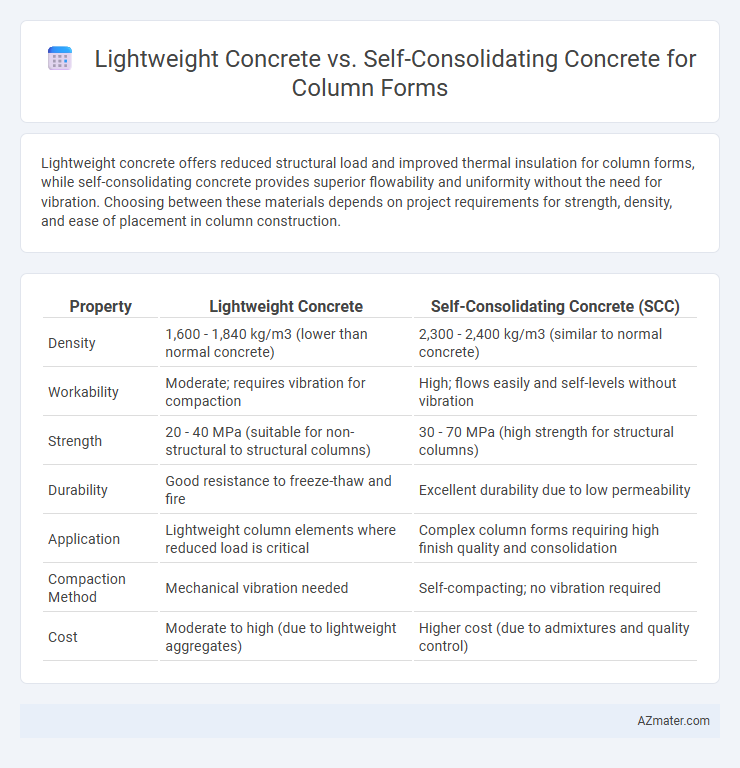Lightweight concrete offers reduced structural load and improved thermal insulation for column forms, while self-consolidating concrete provides superior flowability and uniformity without the need for vibration. Choosing between these materials depends on project requirements for strength, density, and ease of placement in column construction.
Table of Comparison
| Property | Lightweight Concrete | Self-Consolidating Concrete (SCC) |
|---|---|---|
| Density | 1,600 - 1,840 kg/m3 (lower than normal concrete) | 2,300 - 2,400 kg/m3 (similar to normal concrete) |
| Workability | Moderate; requires vibration for compaction | High; flows easily and self-levels without vibration |
| Strength | 20 - 40 MPa (suitable for non-structural to structural columns) | 30 - 70 MPa (high strength for structural columns) |
| Durability | Good resistance to freeze-thaw and fire | Excellent durability due to low permeability |
| Application | Lightweight column elements where reduced load is critical | Complex column forms requiring high finish quality and consolidation |
| Compaction Method | Mechanical vibration needed | Self-compacting; no vibration required |
| Cost | Moderate to high (due to lightweight aggregates) | Higher cost (due to admixtures and quality control) |
Introduction to Lightweight and Self-Consolidating Concrete
Lightweight concrete incorporates lightweight aggregates such as expanded clay or shale, reducing density to improve thermal insulation and reduce structural load in column forms. Self-consolidating concrete (SCC) features high flowability and viscosity, enabling it to fill complex column molds without mechanical vibration while maintaining uniform strength and surface finish. Both materials enhance construction efficiency, with lightweight concrete optimizing weight-sensitive designs and SCC ensuring superior compaction and durability in column applications.
Key Properties of Lightweight Concrete
Lightweight concrete exhibits a significantly lower density, typically ranging between 1,440 to 1,840 kg/m3, which reduces the dead load on column forms and enables easier handling and faster construction. Its high thermal insulation and fire-resistant properties enhance the durability and safety of column structures. While self-consolidating concrete offers superior flowability and eliminates the need for vibration, lightweight concrete's key properties include improved workability, reduced shrinkage, and enhanced freeze-thaw resistance, making it ideal for column form applications where weight reduction is critical.
Key Properties of Self-Consolidating Concrete
Self-consolidating concrete (SCC) exhibits superior flowability and high deformability, enabling it to fill intricate column forms without mechanical vibration, in contrast to lightweight concrete which often requires compaction to avoid voids. SCC's optimized mixture design includes high-range water reducers, viscosity-modifying agents, and fine aggregates, resulting in enhanced surface finish and uniformity crucial for structural columns. Its low segregation and superior cohesiveness reduce honeycombing risks, improving durability and load-bearing capacity in reinforced concrete columns.
Comparing Workability in Column Forms
Lightweight concrete offers moderate workability suitable for column forms but may require vibration to ensure proper compaction and eliminate voids. Self-consolidating concrete (SCC) provides superior flowability and high deformability, allowing it to fill complex column forms without mechanical vibration, reducing labor and time. SCC's enhanced self-leveling properties and resistance to segregation make it ideal for achieving uniform surface finishes and structural integrity in intricate column shapes.
Structural Performance in Column Applications
Lightweight concrete offers reduced dead load and improved thermal insulation in column applications, enhancing overall structural efficiency while maintaining adequate compressive strength. Self-consolidating concrete (SCC) provides superior flowability and consolidation without vibration, ensuring uniformity and minimizing honeycombing in complex column forms. Structural performance of columns benefits from lightweight concrete's load reduction and SCC's exceptional placement quality, with choice depending on load requirements and formwork complexity.
Weight and Load-Bearing Considerations
Lightweight concrete offers significant reductions in structural weight, decreasing the dead load on columns and foundations, making it ideal for high-rise buildings or structures requiring load speed management. Self-consolidating concrete (SCC) provides superior flowability and compaction without vibration, ensuring uniform density and consistent load-bearing capacity in complex column forms. While SCC enhances structural integrity and surface finish quality, lightweight concrete primarily optimizes overall building weight and reduces stresses on load-bearing elements.
Surface Finish and Aesthetics
Lightweight concrete offers a smoother surface finish with reduced shrinkage and improved thermal insulation, making it ideal for aesthetically pleasing column forms. Self-consolidating concrete provides exceptional flowability and compaction without vibration, resulting in uniform, defect-free surfaces and intricate detailing in column molds. Both types enhance column form quality but differ in application efficiency and visual texture.
Durability and Long-Term Performance
Lightweight concrete offers improved thermal insulation and reduced structural load, enhancing the long-term durability of column forms by minimizing stress-induced damage and crack propagation. Self-consolidating concrete (SCC) provides superior workability and uniform compaction without vibration, resulting in higher density and homogeneity that resist moisture ingress and corrosion over time. Durability assessments indicate that SCC columns typically exhibit enhanced resistance to environmental degradation, while lightweight concrete emphasizes energy efficiency and structural resilience in seismic zones.
Cost Implications and Budget Factors
Lightweight concrete reduces overall project costs by lowering material transport and handling expenses due to its reduced density, making it ideal for column formwork where weight constraints are critical. Self-consolidating concrete (SCC) increases initial material costs because of specialized admixtures but decreases labor and formwork expenses by eliminating the need for vibration and allowing faster placement. Budget factors must balance the higher upfront SCC investment against savings in labor and construction speed, while lightweight concrete offers cost efficiency through material reduction and simplified structural support requirements.
Best Use Cases: Choosing the Right Concrete for Columns
Lightweight concrete is ideal for column forms where reducing structural load and improving thermal insulation are critical, especially in high-rise buildings and seismic zones. Self-consolidating concrete excels in complex column molds and congested reinforcement areas by ensuring uniform flow and eliminating the need for vibration, enhancing surface finish and durability. Selecting the right concrete depends on balancing load requirements, form complexity, and construction efficiency for optimal column performance.

Infographic: Lightweight concrete vs Self-consolidating concrete for Column form
 azmater.com
azmater.com